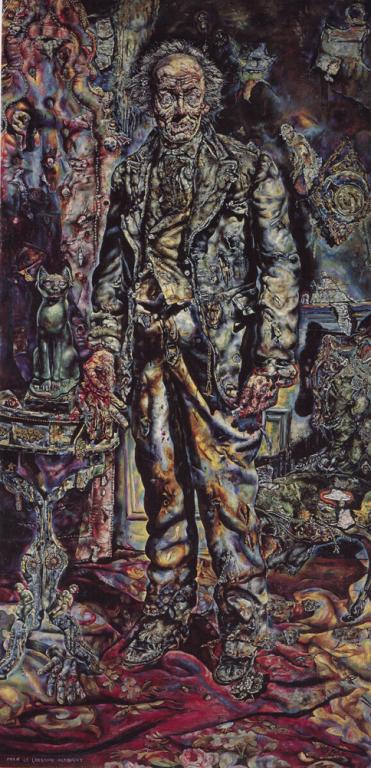In a previous post, I recounted a true story of real evil. The story was true because I experienced it in a particular time and a particular place in history, in this case the Bavarian capital city of Munich. The evil was real because it exemplified and made concrete something that, in its essence, was anti-God and anti-human.
In this post, I examine a theological, philosophical and literary framework that gives some explanation to the real evil we experience in actual historical settings like the one I wrote about. While I do not know if we will ever fully understand the mystery of evil, I still think we can understand it in part. Further, as we begin to grasp the reality of evil in the present world, an additional question arises: the question of what happens to evil in the world to come. In other words, where does evil go when we die?
The Picture of Dorian Gray In Image and Word
One of the most terrifying works of art conceived in the mind of man and executed by the skill of his hand, is Ivan Albright’s 7-foot tall painting of Dorian Gray. Hanging in the halls of the Chicago Art Institute, one could say that any observer who can look upon this monstrosity more than a few minutes without recoiling, might rightly be suspected of either a mental disorder or some serious moral defect. For to gaze too long upon Albright’s “masterpiece,” is quite literally to gaze at an image of human corruption and decay that, in its extraordinary arrangement of matter and form, embodies what is best described in theological terms as “sin.”
Of course, it was for this very purpose that Albright was commissioned. The native of Illinois learned his macabre talent for portraying human flesh sketching battle wounds in France during World War I. He eventually used that talent to create his portrait for a 1945 film rendition of Oscar Wilde’s modern novel about the inner corruption of man. What Wilde captured in words and Albright in paint on canvas, makes for a vivid reminder of a very uncomfortable biblical truth. That truth is the reality of human depravity and the corrupting effect of sin on man’s very being.
Wilde’s story about Dorian Gray as well as Albright’s depiction of Dorian’s inner man further make sense of another Christian doctrine, namely the doctrine of Hell. After all, as many have protested for generations, it seems both irrational and cruel to believe such a harsh doctrine, a doctrine of eternal damnation, unless we also believe that man not only does evil but can actually become it. Wilde’s story probes this possibility with great profundity and in fascinating detail.
A Word About Wilde
The dandyism of the 19th century author and poet Oscar Wilde is renowned in literary history. But it wasn’t just Wilde’s flamboyant dress and sharp tongue that caused him to stand out. The Dubliner’s sexual escapades were as jarring as his external appearance and unrestrained as his creativity. However, those escapades were consistent not just with personal taste but with a particular worldview. Wilde’s libertine lifestyle was borne out of both his metaphysical and moral perspective of the universe. This perspective was not unlike that of one literary successor, Aldous Huxley, who would later explain with great transparency his own reasons for rejecting God’s design of and authority over creation:
I had motive for not wanting the world to have a meaning; consequently assumed that it had none, and was able without any difficulty to find satisfying reasons for this assumption. The philosopher who finds no meaning in the world is not concerned exclusively with a problem in pure metaphysics, he is also concerned to prove that there is no valid reason why he personally should not do as he wants to do, or why his friends should not seize political power and govern in the way that they find most advantageous to themselves. … For myself, the philosophy of meaninglessness was essentially an instrument of liberation, sexual and political.
Huxley, Ends and Means
Like Huxley, Wilde was sexually and politically offensive in his day and age. Albeit, in 19th century Ireland sexual morality and politics were still fused together by laws of conduct, a notion increasingly alien to most Westerners today. Wilde was eventually tried and convicted for the crime of sodomy, a sin that he enjoyed with both under-aged boys and with an egomaniacal relish. Summing up Wilde’s life, fellow Dubliner George Bernard Shaw commented:
Oscar seems to have said: ‘I will love nobody; I will be utterly selfish; and I will be not merely a rascal but a monster; and you shall forgive me everything. In other words, I will reduce your standards to absurdity, not by writing them down, though I could do that as well—in fact, have done it—but by actually living them down and dying them down.
Shaw, “My Memories of Oscar Wilde”
Aestheticism and The Chief End Of Man
However, it was not just some particular lack of moral development in Wilde the man, it was a philosophical orientation he held which facilitated and justified his debauchery. Like many at that time, Oscar embraced fully, indeed more fully than most others in his intellectual circles, the practical outworking of the philosophy of Aestheticism. The British philosopher G.E. Moore articulated late 19th and early 20th century Aestheticism most fully in his book Principia Ethica.
Alasdair MacIntyre, commenting on Moore’s aestheticism, sums up its core tenets:
It turns out to be the case, in the sixth and final chapter of [Moore’s] Principia Ethica, that ‘personal affections and aesthetic enjoyments include all the greatest, and by far the greatest goods we can imagine… ’ This is ‘the ultimate and fundamental truth of Moral Philosophy’. The achievement of friendship and the contemplation of what is beautiful in nature or in art become certainly almost the sole and perhaps the sole justifiable ends of all human action.
MacIntyre, After Virtue
For the aesthete of Wilde’s day, there was nothing more than, that is nothing beyond, the relishing of friendships and the contemplation of art and nature. These are the “sole justifiable ends of all human action.”
While not bad things in themselves, and certainly objectives worthy of pursuit, the pursuit of sensible beauty was still a far cry from the telos found in something like the Westminster Confession of Faith or the Roman Catholic Catechism. The sensible appreciation of nature as an ultimate end of man is categorically different than the chief end of man being “to glorify God and enjoy Him forever.” In effect, Aestheticism exemplifies the great exchange St. Paul speaks about in Romans 1:18-32, where he tell us how man exchanges the creation for its Creator.
It is for this reason that Christ taught the two greatest commands in a very particular order. First, one is to love God with all his heart, soul, mind and strength, and then to love one’s neighbor as oneself. For the aesthete, however, the first part of this command is meaningless, as God is not a reality that can be loved. The second part, therefore, becomes primary. If there is no Creator to love, then the creaturely is elevated in value and treated as its own creator. The results of which are almost always devastating.
Oscar Wilde’s writing is best described as the literary embodiment of this philosophical aestheticism coupled with the moral philosophy of Friedrich Nietzsche. We see this synthesis in his preface to the novel:
The artist is the creator of beautiful things….Those who find beautiful meanings in beautiful things are the cultivated. For these there is hope. They are the elect to whom beautiful things mean only Beauty. There is no such thing as a moral or an immoral book. Books are well written, or badly written. That is all.
Oscar Wilde, The Picture of Dorian Gray
This passage shows Wilde’s thought very much in line with Nietzsche’s attempt to return the concept morality to its pre-Socratic and pre-Christian sense. For Nietzsche and Wilde, morality no longer meant the “slavish” values and obligations of the Judeo-Christian revelation, but the aesthetic aspirations of the Homeric mytho-poetic world. Beauty versus ugliness is the “good versus evil” in Nietzsche’s moral universe, just as it is in Wilde’s. In Nietzsche and Wilde’s cosmos morality has to do with excellence, not with love.
Oscar Wilde’s “wild life” was not predicated on the reality of a divine Nature or the essence of a good God who issues righteous commands. Instead it was predicated on the generative powers of man to create his own heavenly realms. The hope for Wilde was that of becoming one’s own god over the realms one creates, like Nietzsche’s Übermensch. In attempting to live like his own god, Wilde produced his most famous work, Dorian, as intimate an autobiography of an author as one could hope to have.
The Picture of Dorian Gray: A Study in The Ontology Of Sin
In Wilde’s story Dorian’s physical beauty acts as a mirror to his purity of soul and moral innocence. That is, until the antagonist and arch-hedonist Lord Henry Wotton, friend of the painter Basil Hallward, corrupts the young Dorian. Wotton does this by inciting in Dorian the innate, yet latent, narcissism common to all men. The scene takes place in Hallward’s studio, itself described with saccharine flourish.
In Wilde’s novel everything sensual is enhanced for maximum effect. Here, the artist’s world of words expresses Wilde’s own inner proclivities and orientation. It is the world of the aesthete who is also a moral nihilist. Wotton’s character speaks for Wilde as the civilized version of an ancient evil. He is the Mephistopheles of 19th century Romanticism, the Lindwurm of medieval German lore, the tempter in the garden of earthly paradise of the ancient near East.
Through Wotton’s influence, Dorian makes an impulsive wish. He prays that the portrait, Hallward’s finest work, be the thing that ages and corrupts over time, while his real-life material body remains forever young. Wotton’s temptation leads Dorian to unleash an infernal wish, a wish that will make him the center of his own world. This wish is that of the pure sinner. As pure sinner, Dorian’s desire is to bear no consequences, no pangs of conscience and no punishment for carrying out the evil that lurks in his heart. The painting, not Dorian, will bear all the visible marks of his invisible corruption. Dorian’s outward appearance will remain unblemished, and the horror of what he is to become ever obscured to the outside world.
This transference of the evil substance from person to painting, is the central idea that makes Wilde’s book a modern day classic, even if its theme is ancient. Another Irish author, C.S. Lewis, reflected more soberly on this ontology of sin in his most memorable sermon, “The Weight of Glory.” Pondering the immortality of man, Lewis says,
It is a serious thing to live in a society of possible gods and goddesses, to remember that the dullest and most uninteresting person you talk to may one day be a creature which, if you saw it now, you would be strongly tempted to worship, or else a horror and a corruption such as you now meet, if at all, only in a nightmare.
For Lewis, like Wilde, the outward appearance did not do justice to what might be inside the person. Appearance did not necessarily reflect the structure or content of a human soul. As such, what might be revealed at the end of days, may indeed be the most shocking revelation of all, at least after the greater revelation of Christ to man.
The Relation of Beauty to Goodness
This relation of beauty to goodness is as old as human culture. This was something Nietzsche rightly recognized, even if he rejected what had become of that relationship due to Socratic philosophy and ultimately Christianity. Still, the medieval doctrines of the “beatific vision” attest to this deep understanding of moral Good and transcendent Beauty being one and the same in God. In God the Good and Beautiful are one.
It is Wilde’s sundering of this relationship of goodness to beauty that makes Dorian Gray’s story so shocking, yet, at the same time, so realistic. For how many of us truly know our neighbor just by his looks or outward presentation? In the novel many are fooled by Dorian, just as we are often fooled in the real world. Indeed, some scandals in the church today have revealed to us how the cancer of sin often goes unseen in the outward appearance, or speech, of men. Apparently solid edifices of virtue are shown to be no more genuine than a Hollywood stage set. Only later, often too late, do we recognize sin’s true effects on the soul.
Dorian’s Fateful End
Ultimately, Wilde’s story ends when Dorian, having descended into every form of narcissistic iniquity, including murder, is confronted with the now hideous painting. The portrait, in its grotesqueness, crystalizes each of Dorian’s atrocities. In the book’s final chapter, Dorian makes a paltry attempt to turn over a new leaf after his life of evil. He rushes to the painting to see if his newfound “desire” for morality has perhaps altered the painting for the better, returning it to its original state. But, it has not. For even Dorian’s thought of becoming good was one born out of self-preservation and pride. The desire to be good was not pure. It was itself a sin of “cunning hypocrisy.”
Now, unable to endure any longer the endless experiences of pleasure, and the Schadenfreude that accompanied each evil act, Dorian wrongly thinks that trying to act morally will fix his dreadfully boring life. He thinks he can try on virtue, as a vain teenager might try on a trashy prom dress. Wilde’s Dorian is not Dickens’ Scrooge, who is genuinely touched by the divine and transformed. Dorian is a man whose attempt at goodness would be no better than the whitewashed hypocrisy of the scribes and Pharisees. It is a goodness of his own design conceived for his own benefit.
Finally, Dorian succumbs to his hatred for himself and the painting, the only object which shows the true nature of his soul. He tears into the canvas with the same knife that he used to kill its creator, his old “friend” Basil Hallward. Upon slaying the picture, the picture returns to its original state, a portrait of a handsome, young and innocent man. Found dead on the floor is a withered and decayed old man, knife plunged in his heart.
The Nature of Albright’s Imagery
Albright’s portrait of Dorian Gray appears only a few times in the movie. However, director Albert Lewin filmed the revealing of Albright’s picture, which comes toward the film’s end, in full color. The only color scene in the otherwise black-and-white movie. The reason is obvious, as it is not enough to say that Albright’s use of color is “vivid,” rather, it is painful to the eye.
This is no Botticelli figure or Poussin landscape meant to enchant and woo us into wanting to “be in the painting,” as opposed to observing it from without. No. Albright succeeds in his attempt to represent the repulsive in material form. As mentioned above, to not be repulsed at this “after” image of Dorian is to be either insane or immoral. There is no beauty to be found here, only horror. To want to be in this picture, is to want to be in courtship with the devil. Photos of visitors to the Chicago Art Institute in the early days of the paintings public release demonstrate the appropriate reaction to the work.
But, what is it about Albright’s work that makes us convulse and turn away? Like one of his own favorite artists, the 16th century German master, Albrecht Dürer, Albright captures something that is, on the one hand, entirely realistic as all of his objects can be found in the same spacetime reality we occupy. But, on the other hand, this realism is imbued with something quite mystical, or better said, something quite metaphysical. One German art critic referred to Albright’s style as “Magic Realism,” but it might be the philosopher or theologian who can better articulate the “quiddity” that Albright has rendered through his composition, that is its Metaphysical Realism.
The Metaphysics of Sin
Although Metaphysical Realism has been the underdog in philosophy departments since Hume’s skepticism and Kant’s critique of metaphysical knowledge, there has nevertheless always been a vibrant strain of Metaphysical Realism in Christian philosophy. In a technical sense, Metaphysical Realism deals with intricate notions about the existence of things like universals and properties. In a more basic sense, however, it simply affirms the reality of substances, to include immaterial substances like angels and demons, minds or souls. In philosophy these are considered concrete objects, not abstract ones. Concrete objects, unlike numbers or shapes, possess not only existence but also have causal powers and even moral natures.
The genius of Wilde’s novel and Albright’s portrait inheres in the demonstration of this dynamic between material body and immaterial, yet substantive, soul. The nature of the soul, its moral structure and causal powers, is affected by the conscious choices it makes. These choices are instantiated in the physical world through the body. Dorian’s sordid intentions, his lurid thoughts and most depraved fantasies, all of which are immaterial, are actualized in the physical world through his embodied acts. For Wilde, these immaterial desires are transmitted to his physical form. He does not just commit sins, he literally becomes sin.
In his own modern classic, The Great Divorce, C.S. Lewis presents us with a similar take on the ontology of sin. In the book, ghostly figures who linger in the “grey town” are transported in an angelic bus up to heaven. There, they are given one more chance at redemption, one more opportunity to choose God’s grace over their sins. In the end, only one of the ghosts does so.
In several places, Lewis displays this understanding of sin as an ontological substance, as something we are, or become, and not just something we do. In one scene, he portrays a woman who has through her sin of protesting, in the book “grumbling,” become not just one who protests, but one who is a protest. An image perhaps quite relevant in lieu of our current political culture of resentment. The grumbling woman has, or, as the plot goes, is on the brink of becoming “A Grumble.”
Alternatively, the lustful man in chapter eleven, the only one who accepts salvation, is shown being united to that which was once his sin. Now, having been redeemed, both man and his sin are transmogrified into noble rider and faithful stallion. The new man is now one with his virtue as ungodly lust becomes glorious power. But, for the others who choose to return to The Grey Town, there is no transformation.
Hell: The Possibility of Eternal Corruption
Still, does this idea of sin as an ontological substance make the doctrine of Hell more palatable? After all, are not Wilde’s and Lewis’ novels and Albright’s art mere imaginations born in the minds of men?
Perhaps. Although, as I pointed out above, I have written about this not just in theory.
However, if the metaphysical realist is correct, and if we take the biblical texts seriously, let alone the atrocities of our own times, then the reality of sin and its effects on the very substance of our souls should also be taken most seriously. The doctrine of eternal, conscious torment may indeed be a hard doctrine to deliver to contemporary culture. However, just because it is difficult, does not mean it is invalid or untrue. As Lewis himself points out, it is the abrasive and bizarre doctrines we find in Scripture that give evidence of its divine origins,
If our religion is something objective, then we must never avert our eyes from those elements in it which seem puzzling or repellent; for it will be precisely the puzzling or the repellent which conceals what we do not yet know and need to know.
Lewis, “The Weight of Glory”
That Hell is both a puzzling and repellent doctrine is certainly the case. However, what would the just person say if one day, standing in Gallery 262 in the Chicago Art Institute, she saw Albright’s picture of Dorian Gray slowly emerge from its canvas and move toward her and her toddler standing by her side? Is it so hard to imagine she might scream out something like, “Oh God, please damn that thing!”?
If she did, would she be wrong to do so?
History testifies that Oscar Wilde was accepted into the Roman Catholic Church through a valid baptism just days before his death. Only God knows the status of Wilde’s soul now, but at the end of his physical life he seemed to die within the safe havens of the Church. But, if that is not always the case, what else might we conclude about the final destination of the “dead?”

Photo of Oscar Wilde: Unknown photographer, Public domain, via Wikimedia Commons
Ivan Albright, Public domain, via Wikimedia Commons














